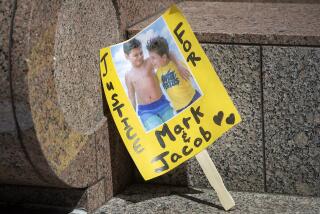Caro Team Focuses on Ambulance Workers
- Share via
Hammering away at one of their main themes, defense attorneys Wednesday suggested that crucial evidence was mishandled by rescue crews at the Santa Rosa Valley home where three young brothers lay dead in their bloodstained beds.
Their mother, Socorro Caro, 44, has been charged with three counts of first-degree murder.
On Wednesday, Caro sat quietly at the defense table in a Ventura County courtroom--a marked contrast from the previous day, when she collapsed in tears during an afternoon break.
In cross-examining members of an ambulance crew, Caro’s lead attorney, Assistant Public Defender Jean Farley, tried to drive home her allegation that the boys’ bedding had been rearranged by emergency workers hoping to save their lives.
That allegation is important to Caro’s contention that the pattern of spatter and stain on the bloody sheets and blankets would have told a tale different than the one prosecutors are trying to prove.
The defense contends Caro was framed for her children’s execution-style shootings by her husband, Dr. Xavier Caro, with whom she had argued hours before the killings on the night of Nov. 22, 1999.
Xavier Caro, who was not named as a suspect by police, is expected to testify this week. Socorro Caro faces life in prison or the death penalty if convicted.
Under questioning from attorneys, Bryan Bowen, a member of an ambulance crew at the Caro home near Camarillo, told the jury how he had futilely checked each child for vital signs.
Bowen had also helped in the effort to aid Socorro Caro, who lay on her bedroom floor with a near-fatal gunshot wound to the head.
When Farley suggested Bowen and his partners were working at excessive speed, Bowen objected.
“Speed in the sense of rushing through it?” he said. “No ma’am. It was a nice, consistent pace.”
Testimony Conflicts With Tape-Recording
Realizing it was a crime scene, Bowen said he took care not to disturb the boys’ bedding. He also said he moved their bodies only enough to check their wounds--each had been shot in the head--and to determine whether their airways were blocked.
When asked by Farley, Bowen said he did not remember pulling a sheet over the body of 11-year-old Joey. Farley, however, produced a tape-recording of Bowen telling an investigator at the scene that he had done just that.
On the witness stand, Bowen testified he had not intended to alter anything that might prove useful as evidence. After moving Joey’s body slightly, Bowen said, he took pains to restore it to something resembling its original position.
“Being fully aware of the crime-scene situation, my entire intent was to have the patient, the sheets, everything, in the condition I found them,” he said.
Farley sounded the same note in questioning Dan Thompson, who had been a homicide detective for the Ventura County Sheriff’s Department.
Thompson said he led Xavier Caro back into his five-bedroom home the day after the slayings.
As the father gathered clothing and toiletries from a home that had been declared a crime scene, he opened a dresser drawer in the master bedroom’s walk-in closet.
‘He Was Crying and Shaking,’ Witness Says
There, he found his wedding ring threaded onto his clasped gold bracelet, just as he had left it the previous night. But he burst into tears, Thompson said, when he saw that now the bracelet also ran through two other rings--Socorro Caro’s engagement ring and wedding ring.
“He was crying and shaking,” Thompson said.
Responding to Farley, Thompson said he was uncertain whether he wore plastic gloves during this visit to the crime scene and was sure that Xavier Caro did not.
He also said he made no notes of the items Xavier Caro took from the home--including his bracelet and ring, which he was allowed to keep overnight.
More to Read
Sign up for Essential California
The most important California stories and recommendations in your inbox every morning.
You may occasionally receive promotional content from the Los Angeles Times.














